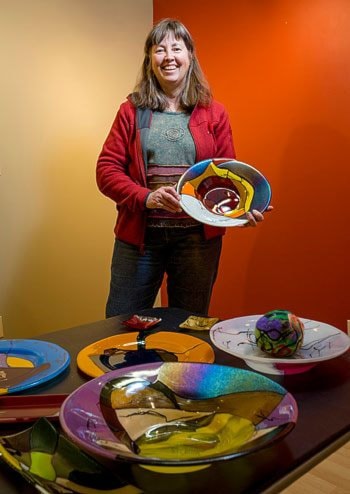The German city of Mainz was a target of multiple Allied bombings during the Second World War, when over 30 air raids destroyed more than 80 per cent of the city’s centre.
What followed after the war was a collective effort to restore many of the churches and cathedrals that had been damaged around the city.
Johannes Schreiter, a famous German architectural glass artist, was among those who took part in restoring the windows to those historic buildings, including the 1,000-year-old Roman Catholic cathedral in Mainz.
Yukon artist Jeanine Baker’s new show, Light and Line, was inspired in large part by Schreiter’s work.
The show will feature close to 20 pieces of fused and stained glass, as well as several felted wool works.
Baker said she’s admired Schreiter’s work for years.
“After the Second World War the Germans developed a very modern approach to stained glass art to rebuild church windows,” she said.
“They created beautiful, abstract windows that are pretty fantastic. I haven’t been to Germany yet, but when I get there I’ll visit those historic buildings.”
She will also have a book about Schreiter’s work on display at the show so visitors can see the inspiration she drew from him, she said.
Baker works out of her studio near Mount Sima, where she takes regular walks along the TransCanada Trail to soak in the territory’s colours throughout the seasons.
One of her favourite thinking spots is a bench by a little lake that is right across the road. “There are subtleties, shadows and translucencies,” she said.
“It could be the clouds or the evening light at 5 p.m., or walking in a forest with a white background and the dark trees against a glowing sky.”
One piece of fused glass, called Dawn, features bright yellow, dark blue and red with copper inclusions.
Before creating new artwork Baker first determines the size and shape of each piece of glass.
Then, she creates a drawing and cuts the glass to fit the shapes using a cutter, running pliers and a diamond router.
She lightly glues them to a base sheet of clear glass, which goes into a kiln at 1,480 degrees Fahrenheit for 10 minutes.
That fuses the glass together, creating a flat, smooth surface on which Baker can paint before a second fusing takes place.
For this show she’s using a display method called stand-off, which uses brackets and fasteners along with a strong adhesive to display the art about an inch away from the wall.
The wool felts were created outdoors in the company of a friend. They made a campfire, boiled some water and started the process.
Applying warm, soapy water to layers of wool, coupled with repeated agitation, causes the fibres to form into a single piece of fabric.
Instead of making the canvas out of glass this time, she wet felted the base out of wool. After the pieces were all dry, she went back in with dry needle felting and completed the line work on them.
The lines found in her artwork represent a place of refuge, she said.
“Once you set your course, you’re spending time seeing where the patterns take you. You can start with a sweeping line and make it thicker or thinner, it’s almost like music.”
She said she’s excited about the opening of Lumel Studios, the Yukon’s first glassblowing studio, later this year.
Luann and Mel Johnson are working on the construction of the building, which is located near the Kwanlin Dun Cultural Centre.
Although Baker doesn’t work with hot glass - she works with warm and cold - she said she’s become good friends with Luann since the beginning of the project.
“She accuses me of getting her a little bit excited about fused glass,” Baker said with a laugh.
Baker’s show opens with a reception this evening from 5 to 8 p.m. at the Yukon Artists @ Work Gallery and runs until Nov. 25.
Contact Myles Dolphin at
myles@yukon-news.com
